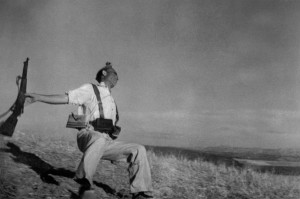At the age of 23, Robert Capa took a photograph that many have labeled the greatest war photograph of all time. Taken during the Spanish Civil War, the renown of Capa’s photograph, Falling Soldier or Death of a Loyalist Soldier, reverberated around the world as it was published and republished in contemporary news magazines. However, Capa’s photo has been shadowed by controversy, including accusations of fakery. Read an analysis on the image by Capa’s biographer, Robert Whelan, on the authenticity of the photograph. Do you find his arguments convincing? Do you think Capa’s photograph is staged or not? And do you think its authenticity matters?
Richard Whelan’s discussion of Capa’s photograph
Please post your responses by Saturday, May 12th. Yes, you have until the end of the semester!





Robert Capa’s photograph, Death of a Loyalist Solider, is known as the greatest war photograph. Richard Whelan’s analysis provides convincing evidence to prove that this critically acclaimed photograph is not staged. All of the major accusations made over the years were proven either false or unlikely. For example, the assumption that the left hand of the solider was instinctively trying to break his fall, which is something that a dead and limp body would not do. However the fingers are curled towards the palm of his hand which shows that his muscles have gone limp. When your photo is known as the greatest war photograph, authenticity is a big factor. With Whelan’s analysis, I feel that Capa’s photo deserves this title.
Richard Whelan’s showed great evidence to explain why death of the loyalist solider was not staged. If i saw the photo for the fist time I wouldn’t think its fake due to how his chest is popped out and his arm with the gun is pushed back as if there was some type of impact on his body. The direction he’s facing is also the direction he’s falling, that to me looks like the force of impact showed correct body expression. Back in the day the photo authenticity probably did matter since its suppose to be an actual image of the war.
I do think that the Greatest War Photograph by Robert Capa is staged because there are no bodies on the ground. Also there is only one solider presented in the photograph if it is a war there should be more than one solider fighting for the cause. There is no blood spatter from the impact of the bullet. Finally it looks staged because the solider just looks like he is just falling down and does not look like he is hurt
Robert Capa’s photography, was truly amazing and it is difficult to say that this image was stage. In my opinion, this photograph was black and white making it a bit hard to distinguish certain details from the picture. In contracts, this picture is of a falling solider who appear to have been shot; yet while at battle was taking place in the images there was only one solider was shot in the middle of the war. As I took a closer look at the picture of the solider that seem to have been losing his balance as he fell and the way his arm were placed as.
Based on reading Richard Whelan’s analysis of Robert Capa’s photograph, Death of a Loyalist Solider, I agree with Steon Nichols that Richard does provide convincing evidence to prove that Robert Capa’s photograph is indeed authentic. Richard’s report vividly explains that most of the accusations over the years about the photograph being staged were either not true or highly unlikely. After reading his analysis myself even I am convinced that it is very much authentic. Everyone is entitled to their own opinion about the photograph whether its real or not, but if it is or isn’t I have to say that’s one hell of shot to capture especially during that time in the 1930s. Outstanding Photograph bottom line.